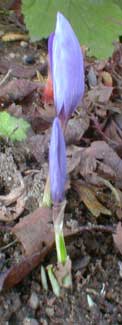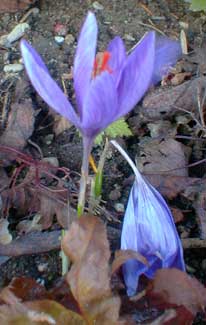
Banded Autumn Crocus
"Out of the tender gloom
Of mists serene & fine,
Like faithful little lamps
You light this path of mine."
-from Louise Morgan Sill's
"Crocuses at Evening"
1928
"Crocuses at Evening"
1928
 Although still sometimes packaged as Crocus zonantus, the currently recognized name for this species is C. kotschyanus. It is native from Lebanon & Turkey.
Although still sometimes packaged as Crocus zonantus, the currently recognized name for this species is C. kotschyanus. It is native from Lebanon & Turkey. This is a lavender-blue crocus with orange-red stamins, blooming in Autumn, early November in our garden, but in many gardens in October. Its grassy leaves appear by February & can last until about June, aging to a golden yellow.
It can be a "tippy" crocus (though not as badly so as C. speciosus) that needs some groundcover companion plant to hold it up, such as closely cropped lawn turf. We tried it amidst an evergreen ornamental strawberry which for all its low-growing creeping behavior turned out to grow tall enough to completely hide the crocus blooms. So the bulbs were later lifted & placed elsewhere, without an upholding companion groundcover.
To show themselves at their best all weather conditions have to suit them. If they are flowering during persistently overcast days, they may never open to their full beauty before wind & rain ruins them. A rainy patch just as they are opening can also batter them to the ground in a very short time. Because of their sensitivity to weather conditions some people prefer them for their reliability for indoor forcing.
Frankly, for the open garden, the long-flowering & beautifully foliaged autumn cyclamens fill the same niche as the autumn crocus far less transiently & without so many ifs & maybes for what will be only a brief showing in a good year.
But I like that brief showing so much that I plant these crocuses without too high an expectation, knowing they're apt to have just the right conditions for an ideal showing only once in three years because our autumns are so stormy & overcast.
A mix of autumn crocuses that bloom at different times increases the chances of a good showing for some of them blooming at moments of ideal conditions. C. speciosa & C. pulchellis bloom for September or early October, followed by C. kotschyanus late October or November, plus there are other autumn blooming varieties worth trying. They'll be followed by the winter crocus C, laevigatus var fontenayi in December & C. ancyrensis in January.
After that, a whole array of Snow Crocuses will be appearing for the big crocus season at winter's end & early spring, & lastly an array of giant Dutch hybrids to mid-spring. Even if some years some of them are beaten down by heavy rainfall, in other years some will put on great shows for one to four weeks & do so back-to-back so that one or another is striving to spice up the yard every month from September to April.
If C. kotschyanus bulbs are planted by August there's a good chance of seeing it bloom that very autumn, but it will be the autumn after that it makes a better showing. It self-seeds very well, though there have been complaints that clones occasionally produce offspring that never bloom. The corm is regarded as edible cooked, though I have as yet never tried them. If it ever does happen that ours cease blooming well, I'll dig 'em up & eat 'em.
It requires a full sun to grow well, naturalize, & for the flowers to open fully. It wants well-draining moist & loamy soil, & does not need to be entirely dry during summer dormancy. After a few years, a successful drift can be very dense & may need the bulbs lifted to replant with better spacing, which should be done late spring when the grass is dying back.